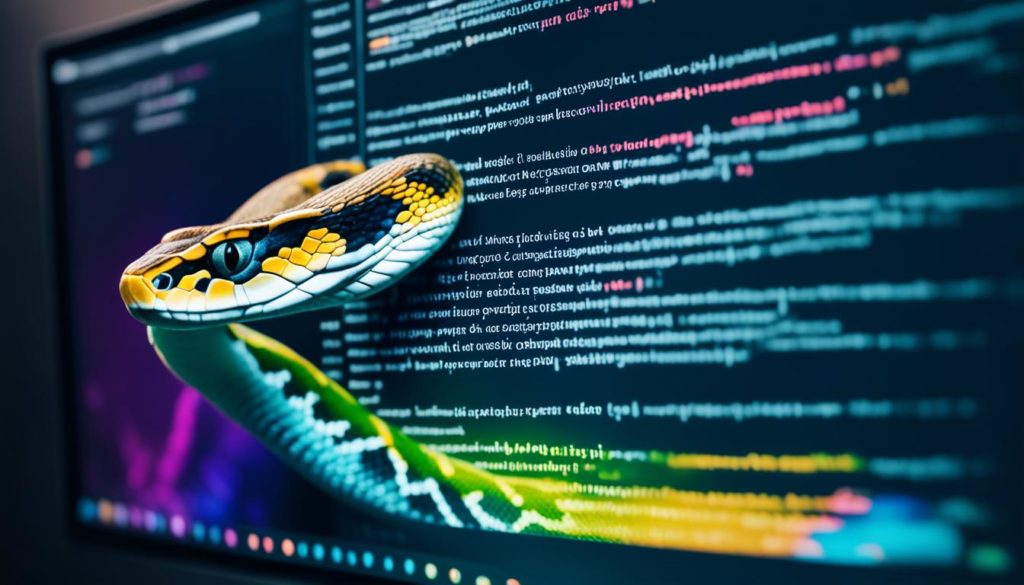
In Feb. 2022, a report by Statista highlighted Python at the third spot among programming languages. It’s used by 48.24% of developers. This is thanks to Python’s many libraries that enhance machine learning tasks. These tasks include data analysis, model training, and making predictions. Python is simple, making it popular among both developers and data scientists.
Python is key in the field of AI known as machine learning. It helps in building predictive models automatically. It uses special algorithms to understand data and make future predictions. Python shines because of its rich library ecosystem. This includes tools like TensorFlow, PyTorch, scikit-learn, and Keras. Each of these is specialized, making everything from complex algorithms to running neural networks easier.
Top Python ML frameworks enjoy lots of use across various fields. Big names like Airbnb, Twitter, Microsoft, and Netflix use Python for machine learning operations. Python stands out due to its vast library and framework options. This aspect makes it a favorite choice for tech tasks. Dive deeper into the best Python machine learning libraries driving progress in AI development.
Key Takeaways
- Python is the third most commonly used programming language by developers globally.
- Machine learning libraries like TensorFlow and PyTorch are widely adopted by tech giants.
- Python’s simplicity and extensive library support make it ideal for machine learning tasks.
- Libraries like Keras and scikit-learn simplify neural network operations and model training.
- Python’s popularity in machine learning is driven by its versatility and resourcefulness in handling complex computations.
Introduction to Python Machine Learning Libraries
Python, launched in 1991, is now a key choice for those in machine learning. It’s praised because it’s easy to read and feels almost like English. Python’s various modules make building AI models smooth.
In the world of machine learning, Python has become a giant. It offers many tools for working with data and making models. Now, we can quickly create models for things like sorting and spotting patterns.
Python’s machine learning tools include NumPy for math work and Scikit-learn for smart models. Pandas helps get data ready for analysis, and TensorFlow is great for deep learning. These are just a few tools in Python’s big box.
Seaborn makes nice-looking charts, while Theano crunches numbers fast. Keras and PyTorch help with complex tasks in AI, like understanding human language. And Matplotlib aids in showing data clearly.
The job market for machine learning is growing fast according to the US government. Learning these Python tools is a smart move for developers. It keeps them ahead in the tech world. The top Python ML libraries are great for tackling the challenges of machine learning.
TensorFlow: A Versatile Machine Learning Library
TensorFlow shines in the world of Python’s ML libraries. It’s an excellent choice for creating deep learning and machine learning apps. Let’s explore what makes it a standout tool.
Overview of TensorFlow
Brought to us by the Google Brain team, TensorFlow is a big name in Python deep learning systems. It stands out for its ability to handle massive tasks, letting us build huge neural networks. This helps greatly with big data and complex computations.
Key Features and Benefits
TensorFlow is known for its many features that serve any skill level. Its main components are:
- TensorFlow Lite: Makes it easy to run ML models on mobile and edge devices.
- TensorFlow.js: Lets you train and use models in your browser with JavaScript or Node.js.
- tf.data: An API that helps you prep your data for machine learning projects.
- TFX: Useful for creating high-quality and scalable ML pipelines.
- tf.keras: A user-friendly way to build and train ML models.
- TensorFlow Datasets: Offers many standard datasets for your projects.
- TensorFlow Board: A tool to help you visualize the performance of your ML models.
Applications and Use Cases
TensorFlow is used widely across many sectors due to its flexibility. Here are some examples:
- Mobile and Edge Computing: TensorFlow Lite allows ML models to run on mobile devices for quick, real-time answers.
- Web-Based Implementations: TensorFlow.js is perfect for working with ML models on websites, making it a go-to for JavaScript devs.
- Data Preprocessing: The tf.data API simplifies the process of setting up your data for ML, improving workflow efficiency.
- Production ML Pipelines: By using TFX, businesses can ensure their ML operations meet high standards of quality and scalability.
TensorFlow’s rich selection of tools makes it a favorite among ML developers. Its use by big players like Airbnb and Twitter also proves its worth in both reliability and flexibility.
For every data scientist and developer, diving into TensorFlow’s many learning materials and staying connected with the community is highly beneficial.
| Component | Description | Use Cases |
|---|---|---|
| TensorFlow Lite | Deploy ML on mobile and edge devices | Android, iOS, Raspberry Pi |
| TensorFlow.js | Train and run models in the browser | JavaScript, Node.js |
| tf.data | API to preprocess data and create input pipelines | Machine Learning Models |
| TFX | Library to create production ML pipelines | MLOps Best Practices |
| tf.keras | High-level API to create ML models | Machine Learning Programming Interface |
PyTorch: Dynamic Computation Graphs
PyTorch is a standout among Python machine learning tools. Since 2016, it’s been known for its dynamic computation graph and easy prototyping. Developed by Meta’s AI team, PyTorch lets you create and train models with just a few lines.
Overview of PyTorch
Meta AI introduced PyTorch in October 2016. It quickly became popular among those working in machine learning. Its dynamic method generates computation graphs while you work. This is very flexible, making it great for testing and creating models.
Key Features and Benefits
The following points show why PyTorch is one of the best Python ML libraries:
- Tensors: Tensors are key for working with data in PyTorch. They help with fast calculations on GPUs.
- Dynamic Computation Graphs: You can build graphs as you need them. This makes debugging and trying new things easy.
- Modules: PyTorch has modules like torch.nn and torch.optim. These handle different parts of model building, like layers, loss functions, and tweaking the model.
- Datasets and Dataloaders: These classes manage big data sets efficiently. They help with loading, batching, and rearranging data.
Applications and Use Cases
PyTorch is great for working with big data sets. Big companies like Microsoft and Meta use it for a variety of machine learning tasks, from recognizing images to analyzing text and making predictions.
Here are some of the ways PyTorch is used:
- Computer Vision: It’s widely used for tasks like identifying elements in pictures and object recognition.
- Natural Language Processing: Projects often use PyTorch for tasks such as figuring out feelings from text and translating languages.
Community and Support
The PyTorch community is known for being innovative and helpful. There’s detailed documentation that covers everything you need to know. This makes it easy to learn, whether you’re just starting or you’re an expert.
The dynamic computation graphs are a big part of what makes PyTorch flexible and powerful. They help keep PyTorch at the top of the Python machine learning world.
| Year | Event |
|---|---|
| 2016 | PyTorch released by Meta AI |
| 2022 | Machine learning market valued at $3.871 billion |
| 2032 | Expected market growth to $49.875 billion |
Keras: Simplified Neural Networks
Keras shines in the Python learning world as an easy-to-use, powerful library for creating neural networks. It’s designed for people first, making it simple to make and test neural networks. This approach opens the door for both new and experienced developers.
Keras is excellent because it lets us mix and match different parts, like neurons and optimizers. This modularity means you get lots of freedom in your work. Companies like Netflix and Yelp use Keras for working with images and text. Plus, it fits well with other Python machine learning tools, speeding up the path from idea to reality.
Another plus for Keras is its quickness. It takes full advantage of TensorFlow’s speed, which means your models run fast. This fast pace shortens how long it takes to try new things, boosting your learning speed. Keras is both easy to use and strong, perfect for making new projects stand out.
FAQ
What are Python machine learning libraries?
Python machine learning libraries are filled with features and methods. These help with math and science tasks. They make it easy to create smart models. You don’t need to understand all the complex math behind them.
Why is Python popular for machine learning?
Python is loved for its easy to learn and use nature. It also boasts a wide range of tools. Plus, it’s great on any computer and has lots of helpers worldwide. All this makes it the first choice for many in creating clever models.
What are some of the best Python ML libraries?
The top picks for ML in Python are TensorFlow, PyTorch, scikit-learn, and Keras. Each one shines in certain areas. They help in going from complex networks to simple tasks easily.
What is TensorFlow used for?
Google Brain’s TensorFlow is key for big-time math and huge models. It fits perfectly in major projects. For example, Airbnb and Twitter use it for their smart data stuff.
What are the key features of PyTorch?
PyTorch stands out for its flexible graph and how easy it is to start a project. Facebook’s AI team made it great for heavy learning and network jobs.
What makes Keras a preferred choice for developers?
Keras wins users over with its easy-to-learn approach and how quick it is. It layers over TensorFlow and Theano making it a popular pick. Everyone finds it user-friendly, from beginners to experts.
How does TensorFlow support large-scale neural networks?
With many math tools and the power to work across many machines, TensorFlow is fit for big jobs. It also helps you see your model’s workings clearly for tweaks and better results.
Who are some notable users of PyTorch?
Big names like Microsoft and Facebook rely on PyTorch for tasks like seeing and understanding pictures, and understanding human language.
Can I use Keras for both image and text data?
Absolutely, Keras handles photos and words equally well. It’s made to work smoothly with these kinds of info. So it’s perfect for all sorts of projects.
Future App Studios is an award-winning software development & outsourcing company. Our team of experts is ready to craft the solution your company needs.










